#afronicity
Explore tagged Tumblr posts
Photo


REMA | AFRONATION
#Rema#Afronation#Afro#Nation#Music#Festival#Concert#Show#Afrobeats#Portugal#summer#summer music#concert pic#concert photography#photography#melanin#africa#nigeria#fashion#all black
129 notes
·
View notes
Text




sillies 1,2 - @springlockedfool's Williams and 3,4 are mine ^-^
20 notes
·
View notes
Text
Artdump!!










If you cant tell I love Max Design Pro. Also fnaf is cool. Also art collab w my friend.
#art collab#invader zim#gir#svene#scene#max design pro#maxdesignpro#maxdesignproart#fear garden#max the monkey#nugget#maxnug#twiddlefinger#twiddlemax#evil max#hope#jimmy#hope the monkey#jimmy the monkey#twiddlefinger DROWNING JIMMY#ucft#undeniably canon fnaf timeline#Eleanor schmidt#mdp sona#william afron#speing bonnie#spring bonnie#fnaf
14 notes
·
View notes
Text
Small hc about Aftons?
I honestly think William hates dad jokes. Unless Elizabeth makes them, then he can tolerate them.
I am a sucker for good ol’ tragic family relationships so, I like to think that William actually cared about his family, but obviously couldn’t fully show that, due to having some underlying issues even before starting the pizzeria chain. William was most likely the middle child in his family, always being left behind and not paid attention to, so he would do close to anything to get any spec of attention for himself (which really boils down to an inferiority complex that leads him down a path of a showman/business dude).
He can’t really show affection other than through gifts or little things he does for his children. Like his kids were always stacked with toys, had food on their plates, clothes to wear and the craziest birthday parties you can imagine with half of town coming to celebrate only you. With this crazy crowd giving you all the attention you could ever ask for, something Will himself never had. But he would never ask if the kids ever wanted that, Evan for example would prefer to have a nice small celebration with his siblings and parents (yet, i don’t think Will could ever believe that). William drowned in his work and of course with mrs. Afton being absent (mentally or physically or even both) he couldn’t take proper care of his kids, other than spying on them with cameras, aaand giving the youngest a freadbear plush with a walkie talkie he could use to comfort him (which is a whole other topic to tackle)
William loves displaying his kids’ art at the restaurant! Out of three of them Elizabeth loves to draw the most, something she got from her mother, she even designed her own animatronic that her dad promised to make one day!
Elizabeth has a weak stomach so anytime she’s in a pizzeria the chefs have to make the best damn pizza they can, or they’ll have to talk to the big papa bear of a boss.
Evan and Elithabeth have motion sickness, which Michael teases them a lot for, unless William is there, because William has the power to remind Michael a bunch of embarrassing stories from when he was a toddler.
Most of the artwork and first design sketches were done by Mrs. Afton, she loved William’s ideas and doodled them. Together they both would polish those to perfection. That’s one of the reasons why Will hated when Henry criticized his blueprints and ideas for not being practical or possible, Henry is just unoriginal and uncreative afterall…
Afton brings home all the prototypes and faulty merchandise. The kids love it and mrs. Afton got tired of it after a while. Since the kids are the only ones who own those prototypes they immediately become envied by other kids. Eli and Evan are too young to be in school, so they show off their toys in their kindergarten classes. Michael mostly brags about it and always tries to get his friends some stuff too, so they can all be cool kids together.
Michael is about 13 yo, Elizabeth is 6 and Evan is 5ish.
Afton’s and Henry’s name badges have little top hats that signify that they’re the owners
51 notes
·
View notes
Video
youtube
Kamo Mphela - @PianoPeopleOfficial Live from @AfroNation Portugal 2024 | @beatport
#youtube#Kamo Mphela - @PianoPeopleOfficial Live from @AfroNation#Kamo Mphela - @PianoPeopleOfficial Live#kamo mphela#@PianoPeopleOfficia#m @AfroNation#Portugal#RSA#SA#Amapiano#music#dance RSA#dance#mzansi
2 notes
·
View notes
Text
Me and Williams wedding will look like a lesbian objectum wedding because my sona is a tv and his fursona is a yellow rabbit and we are gonna be both in dresses
#fnaf#five nights at freddy's#william afton#william afron x me!#self ship#lesbian#objectum#but not really
2 notes
·
View notes
Text
A bit of an update on my life
Simple and sweet, I escaped my mom, I refused to allow myself to be emotionally abused any longer, so I left <3 im now living with my father, which is 100% better for me. I had to unenroll from my previous college, and im currently trying to reenroll in my local university for a Bachelor in Education! So what's up with me now? I found out im part native, specifically of the Choctaw tribe! which has helped me a lot with my own personality and how i expressed myself finding this information out, yes I do identify as Two Spirit now and it's helped me a lot. I also found out that im indeed a Lesbian and have been going through a sort of "Comphet" with my abuser, who turned out to be a predator towards systems. i feel like this is all i needed to update with my life what will happen to my tumblr accounts? im going to archive the Mogai blogs as i dont think im capable of upkeeping multiple blogs anymore, I might turn this blog into a more personal blog for me and also post sims content!! thank you!!
#black ftm#black lesbian#black sapphic#black wlw#tmasc lesbian#he him lesbian#two spirit#afronative#choctaw
2 notes
·
View notes
Text



(@smibtnofest) • Instagram-foto’s en -video’s
2 notes
·
View notes
Note
What are your headcanons on the Aftons visiting the Pizzaplex?
('83 ages)
Elizabeth immediately get lost within 2 seconds of entering the place
Michael is trying to make sure his skin doesn't get stuck or fall on any of the props.
CC is getting to get away from the robots depsite the fact they aren't doing anything
William..yeah he be killing kids like always while Ms Afron get a staff bot hell signs her divorce papers
#fnaf security breach#fnaf headconons#fnaf michael afton#fnaf elizabeth#fnaf cc#fnaf william afton#fnaf ms afron
5 notes
·
View notes
Text

Garry Blackchild , Afro - Indigenous Folk Singer , Taos NM . Photo by Sabine Andrew
#garryblackchild#americana#newmexico#singersongwriter#folk#afro indigenous#afronative#taos#photography#black country music#blackabdwhitephotography
3 notes
·
View notes
Note
About the Rebuilt AU, how do you suppose Lizzie and Evan are feeling about their new lives, and what do they think of Vanny at all? (I feel like we all know how Mike feels about the situation.)
Evan absolutely loathes Vanny (the reasons for which will be clear when I do his character sheet), and isn't very happy about being in an animatronic once again.
Lizzie is good at pretending everything is fine and that she's happy to do along with William's plans, but secretly she doesn't really like it either. She just doesn't want to risk getting hurt again. (Elizabeth feels sympathy for Vanny as she knows what it's like to be trapped under William's "programing")
36 notes
·
View notes
Text
1/422/106-ID - Forced March (Mohn) The Fate of the American POWs of the 106-ID)
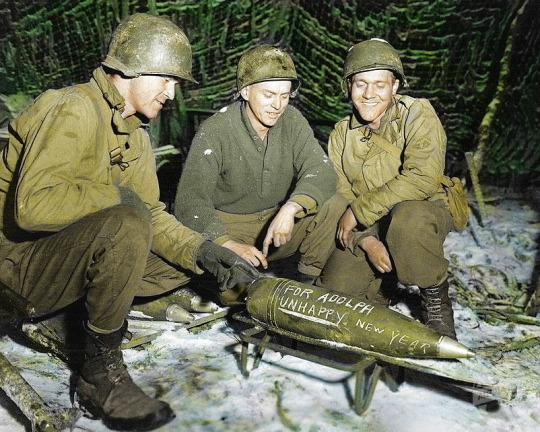
Source Document: Forced March Major John P. Mohn, HQ Co, 1st Battalion, 422nd Infantry Regiment, 106th Infantry Division

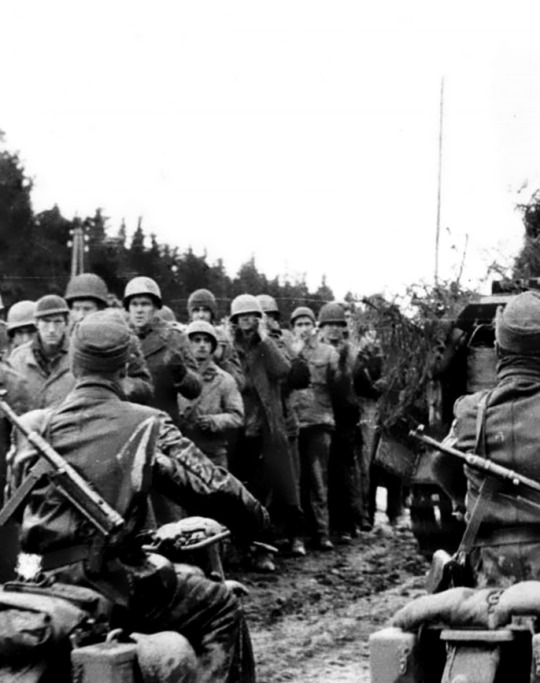
Forced March, from Schoenberg - St Vith (Battle of the Bulge, Belgium) to Berchtesgaden in Germany, is the Prisoner of War memoir of the 1200-mile forced march done by Maj John J. Mohn, Hq Co, 1st Battalion, 442nd Infantry Regiment, 106th Infantry Division, Golden Lion and has been extracted from a book published in Canton, Ohio, USA and printed by PPi Graphics, also in Canton Ohio, (ISBN-13:978-08-9863465-5-2). Being a friend of Mandy Altimus Pond, Maj John J. Mohn's granddaughter, we talked about the publishing of this book on the EUCMH Website and agreed that this work would be a great way to render honor to Maj John J. Mohn and the terrible period he experienced while being one American Prisoner of War in Nazi Germany during the last year of WW-2. Before starting with the text, I would like the reader to notice that combat photos from a surrendered unit in the combat zone don't exist, especially with the 422 and the 423-IRs of the 106-ID. On the morning of Dec 16, 1944, these two infantry regiments, were trapped between two German main axes of penetration; on their front, elements of the 5.Panzer-Army (Manteufeul) coming from Blieaf in Germany and heading to St Vith and on their rear, elements of the 6.Panzer-Army (Dietrich) coming from Lanzerath and Manderfeld heading to Liège via St Vith, didn't give a one of a chance to these two Regimental Combat Teams (422 and 423) which once cut off, without supply, couldn't withdraw in any direction. These men combated up to the last cartridge, then destroyed all their guns, machine guns, and rifles, and finally surrendered. Dedication To my wonderful wife, Cheri, and loving daughter, Debora Mohn Altimus; without whose prodding and encouragement this book would never have been written. And to my son-in-law Richard Altimus who assisted in the computer editing of this book. Editor's Note: Additional thanks to my granddaughter, Mandy Altimus Pond, who helped me with the publishing of her grandpa's book. Maj John J. Mohn, 1/442-IR, 106-ID

Foreword When WW II's Battle of the Bulge began with a surprise German attack on Dec 16, 1944, troops of the US 106th Infantry Division occupied the most exposed American positions. They had been in the European continent for less than two weeks and cut off from reinforcements, were left to face the German onslaught alone. They fought back, standing their ground, but as their ammunition; food and medical supplies dwindled and the enemy noose drew tighter, over 7000 were ordered by their commanding officers to surrender to the surrounding German forces. Except for the Bataan Death March, this was the largest surrender of American troops during WW II. Maj Mohn, of Akron, Ohio, the author of this book, was the Operations Officer of the 1/422-IR. He was a citizen-soldier who had volunteered to join the Army as a private in 1941. This is the story of his 1200-mile odyssey as a prisoner of war to the far reaches of the Nazi empire during which he and his fellow soldiers were starved, frozen, bombed, and shot. Because the Germans were unprepared to absorb a massive influx of American POWs and had little space to house them, Maj Mohn's imprisonment became an almost continuous five-month march through the collapsing and chaotic Third Reich. Initially, he was sent to a camp for American officers over 500 miles away from Poland. He

arrived there only to be marched out of the camp a few days later when the Russian forces broke through the German lines around Warsaw. Seeing the prisoners as a potential bargaining chip and intent on keeping them out of Russian hands, the Germans forced the Americans to make a harrowing march westward across rural Poland and Germany in the dead of winter just ahead of pursuing Soviet forces. After this month-and-a-half ordeal, the prisoners finally arrived at the Hammelburg POW Camp in northern Bavaria, only about 100 miles away from where they started. Two weeks later this camp was attacked and briefly captured by a Task Force of Patton's 3-A. The Germans, however, soon recaptured the camp and immediately sent Maj Mohn and the other prisoners on another dangerous march which ended at the Austrian border five weeks later they were liberated by American troops. Through it all, Maj Mohn preserved and returned to the USA where he underwent treatment and rehabilitation for injuries he had suffered as a prisoner of war. he returned to civilian life and developed a highly successful career as a psychologist. But his remarkable experiences in the military never quite left him. Eventually, he put words to paper and the result is the archive you are about to read - one of the very few accounts of this type ever to have been published. More than just a narrative of his experiences as a POW in Nazi Germany, it is a testament to the indomitable spirit of the US soldiers and a reminder to all of us of the sacrifices they made to preserve our freedom. Before the Battle of the Bulge - Mandy Altimus Pond


About 1937, while attending Akron University, John Mohn took Reserve Officers' Training Corps. John had no desire to become an officer, but by the end of his training, he had reached the rank of 2nd Lieutenant. In preparation for what appeared to be an inevitable world conflict, Congress passed the Selective Service Act in 1940. This was the first peacetime conscription in US history. Enacted in September 1940, this act required men between 21 and 35 years of age to register with local draft boards. Men were drafted by a lottery system and were required to serve for twelve months. After that year was completed, John was told he would be draft-free and not required to sign up, should a war arise. On Feb 4, 1941, John decided to enlist for this program and join the Navy. He drove to Cleveland, entered the Armory, and began the process. He took the written test, passed the physical, and was about to be sworn in when the commanding officer at the Armory said that John's teeth protruded too much and they would not accept him. John stated in an interview that 'this is stupid' and went to the other end of the Armory and enlisted in the Army. At this moment he could have enlisted as a 2nd Lieutenant because of his ROTC training. It slipped his mind and he enlisted as a Private.


John was assigned to the 37-ID at Camp Shelby, Mississippi. He volunteered for the Signal Company (Teletype) and the day after he signed up, the teletype was discontinued, so he was reassigned to supply in the Signal Company and was sent to Indiantown Gap Pa. On Dec 7, 1941, the Japanese attacked Pearl Harbor, and the next day upon request from President Franklin D. Roosevelt, Congress declared war on Japan and their ally Germany. This canceled the draft-free status that John had signed up for, as he had not completed his twelve months of training. His division was scheduled to board a ship headed to the Pacific Theater of the war, but the boat blew up before they could head out.
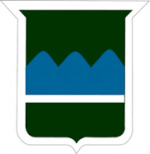
John was then sent to Fort Benning, Georgia, for officer training from February through April 1942. In late 1942, he was sent to Camp Forest and assigned to the 80-ID for a year. He became CO Fox Co, 1/319-IR, 80-ID. His division was in charge of clearing trees in the mountains in preparation for war games, training men in firing artillery, and surviving in realistic battle situations. John was in charge of the logistics and planning for the war games.
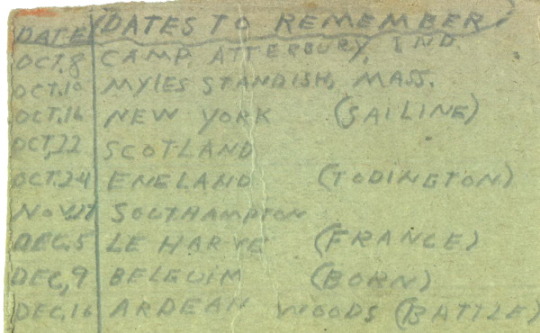
The 80-ID was then incorporated into the 106-ID. John was reassigned as Bn OP Officer and sent to Camp Atterbury, Indiana, and assigned to Hq Co, 1/422-IR, 106-ID. John reached the rank of Captain and was told that he was the youngest Captain in the Division. As Operations Officer, he was in charge of logistics for troop movements. He staged a large 3000-troop parade in Indianapolis in 1944. After our advance movement order was in, we received new equipment, turned in motor vehicles, and did what training we could at odd intervals. Finally, in September we moved by rail to Camp Myles Standish at Taunton, Mass. This place was known as a staging area where life reached the maximum of not letting anyone know anything at all. We existed on a monotonous routine of rumors until the day we redoubled our tracks, returned to New York, boarded the RMS Aquitania, and departed for Gourock, Scotland, on Oct 21, 1944. The 423-IR with various attached units arrived Oct 27, and the 422 and 424-IRs arrived Oct 28 with the artillery and some special units. We moved then to England where we were deployed in one of the most interesting and certainly the most beautiful parts of this country, the Cotswold section of the midlands. The 422-IR was stationed some 12 miles west and northwest of Oxford, the 424-IR near Banbury of Banbury Cross fame, and the 423-IR, and the Division Artillery near Cheltenham and Gloucester respectively. Division headquarters and special units were located centrally in this 200-square-mile area.
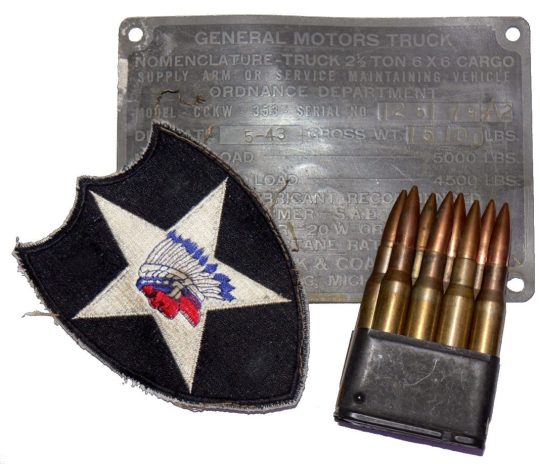
We remained in England preparing for an expected early crossing of the Channel. Between Nov 30 and Dec 1, the Golden Lions embarked on the long slow fifty-mile trip from Southampton to cross the Channel. We disembarked at Le Havre and at Rouen, a town about one-third of the way up the Seine toward Paris, and went into a bivouac in deep mud in the open fields in a cold drizzling rain, between the Dec 1/8.

During these days liaison officers from the 1-A headquarters arrived at odd intervals with conflicting and inconsistent sets of orders, so that during 48 hours we were assigned to three different corps in as many separate locations. Fortunately, troops and staff were arriving in unrelated groups as the weather and the Navy allowed them ashore so that no damage was done except to my disposition. The final messenger appeared on Dec 6 with instructions for us to leave for the St Vith area in Belgium. The first combat team to move, left the area on Dec 8, followed by the others as rapidly as possible. Upon arrival, we were to relieve the 2-ID, then in a defensive position, as part of the VIII Corps whose headquarters was then at Bastogne. Troops being in the throes of landing after a rough winter crossing, staffs only partly present and maps few and far between, our move to the battlefield was a rather remarkable one and highly successful despite its discomfort. The route carried us nearly 300 miles through Amiens, Cambrai, and Maubeuge in France to Philippeville in Belgium. After an overnight bivouac in extra deep mud near the latter town, we passed through Marche and the villages of eastern Belgium to the vicinity of St Vith, arriving during the period Dec 9/15. The relief of the 2-ID's weary troops stationed along the quiet German border in the Belgian Ardennes Forest commenced on Dec 11, and was completed on Dec 13, responsibility for the defense of the sector passing to me on Dec 12. The troops of the Indian head Division assured the men of the Golden Lion Division that there would be little action on this hilly terrain in the middle of winter. Edward P. McHugh

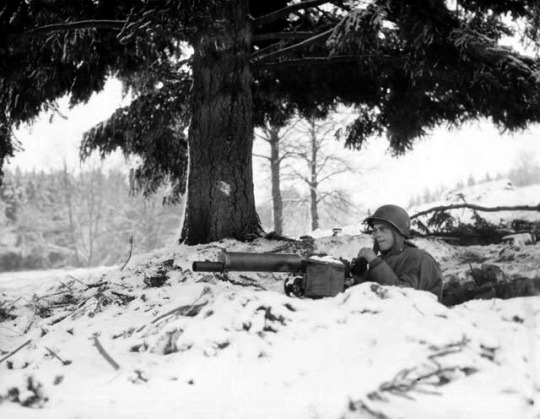
Preface - Maj John J. Mohn It was Dec 16, 1944, somewhere along the Siegfried Line near St Vith, Belgium. The German counter-attack that would later be referred to as the Battle of the Bulge had begun. The gray, foggy dawn made a perfect umbrella for the German launching of an onslaught that nearly cost the Allies World War Two. What happened at the Battle of the Bulge may be a well-known story but none of the stories make any reference to the group of American Soldiers taken prisoner at that time and marched for 140 continuous days covering over 1200 long, cold, starvation-ridden, nightmare miles, terminated only by the end of the war in Europe. Adversity is a mild term to describe the unbearable hardships endured by the ever-changing, ever-diminishing column of men. Temperatures dropped to ten degrees below zero (22°F). There were periods of fifteen days without a single bite of food. All suffered a phenomenal loss of weight (I weighed 65 pounds by the time of the liberation). We had inadequate clothing; many were without hats or gloves and at times no shoes. It was especially brutal for the poor Army Air Corpsmen who were only wearing thermal boots with no soles for walking when they were shot down and captured. The journey was marked by frozen feet, legs, arms, faces, and even blood trails. Treachery, deceit, and fear are just feeble attempts to put into words the anger, horror, anguish, and despair felt by these military men.

The ordeal that the approximately 7000 US soldiers endured between Dec 16/44 and May 2/45 can only be epitomized by saying that a scant thirty of the original group even reached liberation as a unit. Losses of men beyond belief resulted from attempts at escape, exposure, starvation, the sadism of the German Guards, and being strafed daily by our own and Allied planes. My book is not intended as a condemnation of the German People or Army but does make reference to differing attitudes and treatment by the Wehrmacht, to whom I owe a debt of gratitude for being alive, and the Elite SS Troops, who were constantly threatening our lives with attempts to exterminate us with machine guns and failed to provide even the most basic of necessities for our daily maintenance. The German High Command seemed at a loss as to what to do with so many prisoners and lacked a plan regarding the disposition of us. The result was a wandering march covering three countries with no apparent purpose, with a final goal of holding us as hostages in Berchtesgaden at the end of the war. The consequences for us, as Prisoners of War, were painfully clear. The facts and sequences of events I know first-hand because I was there from the beginning to the end. I saw dramatic changes in attitudes, values, behavior, and beliefs. Hidden strengths and weaknesses in the struggle for survival were surprising and at times frightening, but the salient factor through it all was that survival is 'All-Important' and that the 'Veneer of Civilization' is extremely thin.

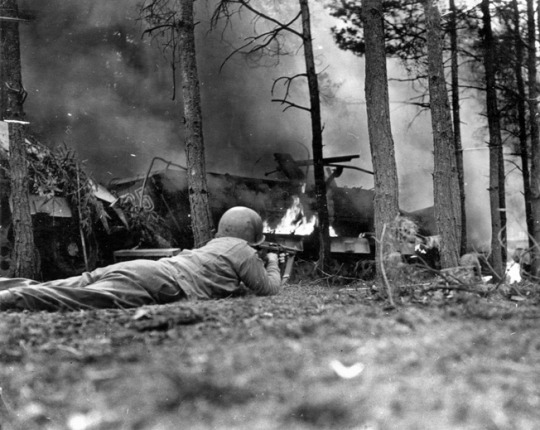
December 16, the Horror Begins I couldn't help being reminded of that famous poem by Rudyard Kipling 'The Charge of the Light Brigade' on that fateful, foggy, grey, cold, drizzling morning Dec 16, 1944. The difference was that instead of 'cannons' noted in the poem, we had German tanks to the left of us, tanks to the right of us, tanks in front of us, and tanks behind us. To 'charge' ahead would have been to go down the steep slope of an evergreen-covered mountain. The landscape was so much like the mountain areas of Pennsylvania that it was hard to remember that we were in a foreign country fighting a very serious war. Even more seriously, we were surrounded and annihilated by German Panzer Divisions from the left and right of us. German artillery from the front was terrible enough but, to our dismay, the Germans had captured our artillery and were using our guns to fire upon us from the rear. When we called for supporting fire, they were aiming at us instead of their troops. Our Battalion Commander, Col Thomas Kent was killed by a shell coming in from the rear of our 'Pillbox' command post. At first, we thought our artillerymen were firing short of their target, but when we heard the German voice on our radio, we realized the awful truth - we were literally at their mercy. The divide-and-conquer strategy used in the German attack had been completely unexpected and effective. Read the full article
#106thInfantryDivision#28thInfantryDivision#2ndInfantryDivision#3-A(US)#422ndInfantryRegiment#5.PA(German)#6.Panzer-Army#80-ID(US)#9-AD(US)#Afron#BalticSea#BataanDeathMarch#BattleoftheBulge#Belgium#Berchtesgaden#Bleialf(Germany)#CampMylesStandish#CampShelby#DeboraMohnAltimus#December1944#EdwardP.McHugh#Falkenberg#Fatherland#FortBenning#GenAllanW.Jones#GenevaConvention#Germany#HammelburgPWCamp#HQsCo1/422#IndiantownGap
2 notes
·
View notes
Text

#digital illustration#digital art#digital painting#wip#procreate#obatala#afroamerican#afro latino#orishas#yoruba#afromexican#afronative#afrocuban#carribbean#white clothing#peace#sky#bird#process
10 notes
·
View notes
Text
A video of my baby 😢💔❤️
This is the man they befriended then murdered.
youtube
#twoclouds#niishwakakumahkwak#muriydwilliams#mmip#injustice#blackindiansmatter#blackindians#afronative#afroindigenous#Youtube
7 notes
·
View notes
Photo

ig @bantuuking
#male portrait#fashion portrait#photo portrait#by bantuuking#ernest essiane#essiane ernest#best#picoftheday#google pictures#Pinterest#parist#black model#vibe#good vibe quotes#beau#black beauty#afronation#afropunk#afro art
8 notes
·
View notes
Text
For the very first time, Afro Nation is set to make its debut in Nigeria.
Afro Nation, the highly acclaimed music festival that has captivated audiences across the diaspora, is making its long-awaited debut in Nigeria. Since its inception in Portugal four years ago, Afro Nation has successfully spread the infectious energy of Afro Beats to numerous countries, culminating in a recent installment in Miami. The decision to bring Afro Nation to Nigeria stems from the…

View On WordPress
2 notes
·
View notes